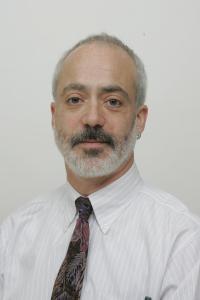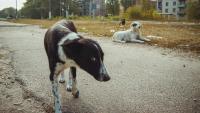Norman Kleiman, PhD, MS
- Associate Professor of Environmental Health Sciences at CUMC
On the web

Overview
Dr. Kleiman works at the intersection of public health, radiation research and ophthalmology, often using the eye as a model system to study the effects of environmental exposures, and radiation in particular, on human and animal health. For example, NASA and DOE funded research projects were designed to better understand ocular risks, and radiation cataract in particular, underlying eye exposure to low doses of different kinds of radiation, e.g. X-rays and high energy space radiation, (think cosmic rays). Related human research in Dr. Kleiman's laboratory estimates relative risk of radiation cataract in medical professionals such as interventional cardiologists and associated nursing personnel following occupational exposure to X-ray during fluoroscopic imaging procedures. A collaborative study with Ukrainian colleagues examines ocular radiation risk in Chornobyl accident cleanup workers. Recently, new projects have examined health risks posed by exposure to radiation, heavy metals and other environmental hazards in mice, voles and semi-domesticated dogs living within the Chornobyl exclusion zone. In other areas related to eye pathology, a NIEHS funded project investigates the potential relationship between arsenic exposure and cataract and recently reported significantly elevated arsenic concentrations in eye tissue. A recently funded NIEHS study examines the potentially carcinogenic heavy metal risks associated with e-cigarette use. At a mechanistic level, Dr. Kleiman applies molecular and biochemical approaches to examine how environmental toxins such as radiation, heavy metals or e-cigarette use causes DNA damage, misrepair and mutagenesis and how individual genetic determinants influence risk. Overall, these investigations help in formulating appropriate risk policies and aid in development of human exposure guidelines as well as having important therapeutic implications for radio- and/or chemo-sensitive subsets of the human population. Among other responsibilities, Dr. Kleiman is a technical cooperation expert for the International Atomic Energy Agency and serves on scientific committees of the National Council on Radiation Protection (NCRP) and the International Commission on Radiological Protection (ICRP).
Office Location: 722 West 168th Street, ARB 1113
Academic Appointments
- Associate Professor of Environmental Health Sciences at CUMC
Administrative Titles
- Director, Radiation Safety Officer Training Course
- Director, Eye Radiation and Environmental Research Laboratory
- Advisory Council, Center for Radiological Research
- Vice-Chair, Institutional Animal Care and Use Committee (IACUC)
- Chair, Faculty Steering Committee
Credentials & Experience
Education & Training
- BS, 1979 Rensselaer Polytechnic Institute
- MS, 1982 Vanderbilt University
- PhD, 1985 Vanderbilt University
Committees, Societies, Councils
Editorial Boards
Academic Editor, PLoS One
Associate Editor, Frontiers in Radiation and Health
Faculty Advisory Board-The Journal of Global Health
Honors & Awards
Journal of Vascular and Interventional Radiology (JVIR): Outstanding Clinical Research Paper of 2013
Research
Research Interests
- Aging
- Environmental Health
- Genetics
- Public Health Education
Selected Publications
Welch D, Kleiman NJ, Arden PA, Kuryla CL, Buonano M, Wu X, Brenner DJ. Far-UVC induced skin cancer is not observed in mice after long-term exposure to filtered 222 nm radiation. Photochem Photobiol 2022; doi: 10.1111/php.13656
Re DB, Hilpert M, Saglimbeni B, Strait M, Ilievski V, Coady M, Talayero M, Wilmsen K, Chesnais H, Balac O, Glabonjat RA, Slavkovich V, Yan B, Graziano J, Navas-Acien A, Kleiman NJ. Exposure to e-cigarette aerosol over two months induces accumulation of neurotoxic metals and alteration of essential metals in mouse brain. Environ Res 2021; 202:111557.
Balter S, Rodriguez MA, Pike JA, Kleiman NJ. Microbial contamination risk and disinfection of radiation protective garments. Health Phys 2021; 120:123-30.
Zhao D, Navas-Acien A, Ilievski V, Slavkovich V, Olmedo P, Adria Mora B, Domingo-Relloso A, Aherrera A, Kleiman NJ, Rule A, Hilpert M. Metal concentrations in aerosols from open-system and closed-system electronic cigarette devices. Environ Res 2019; 174:125-34.
Paul S, Kleiman NJ, Amundson SA. Transcriptomic responses in mouse blood during the first week after in vivo gamma irradiation. Sci Rep 2019; 9:18364.
Trichter S, Soares CG, Zaider M, DeWyngaer JK, DeWerd LA, Kleiman, NJ. 15 Years of 106Ru eye plaque dosimetry at Memorial Sloan-Kettering Cancer Center and Weill Cornell Medical Center using radiochromic Film in a solid water phantom. Biomed Phys Eng Express 2018; 4:045017.
Kleiman NJ, Stewart FA, Hall EJ. Modifiers of radiation effects in the eye. Life Sci Space Res (Amst) 2017; 15:43-54.
Kleiman NJ, Quinn AM, Fields KG, Slavkovich V, Graziano JG. Arsenite accumulation in the mouse eye. J Toxicol Environ Health A 2016; 79:339-41.
Son, AI, Shelag, M, Cooper, MA, Sun, Y, Kleiman, NJ, Zhou, R. Formation of persistent hyperplastic primary vitreous in Ephrin-A5-/- mice. Invest Ophthalmol Vis Sci 2014; 55:1594-1606.
Vano E, Kleiman NJ, Duran A, Romano M, Rehani, MM. Radiation associated lens opacities in catheterization personnel: Results of a survey and direct assessments. J Vasc Interv Radiol 2013; 4:197-204.
Global Health Activities
International Atomic Energy Agency (IAEA) Technical Co-Operation Expert, World: IAEA specialists are a key element in the technical cooperation programme (TCP) and assist developing Member States to achieve self-reliance in numerous scientific and technological fields. Specific tasks are defined by the scope and objectives of the individual projects within the TCP. Typically, expert services include provision of advice to counterparts in the field, lecturing at training courses, and contributions to meeting/workshops. Technical Co-Operation experts possess sophisticated scientific and technical knowledge, and have the ability to share it effectively with others.
U.S. Director; Ukrainian American Chernobyl Ocular Study (UACOS), Ukraine: The Chernobyl nuclear reactor accident in 1986 and resultant explosion and fire caused radioactive contamination of large areas of Belarus and Ukraine. More than 600,000 individuals (Liquidators) were involved in clean-up and maintenance activities at the site. Many thousands were exposed to low doses of ionizing radiation. The Ukrainian American Chernobyl Ocular Study (UACOS) was established in 1996 to monitor the effects of this radiation exposure on the eyes of clean-up workers. Among eye tissue, the lens is most radiosensitive. Time and dose dependent development of posterior subcapsular cataracts (psc) following radiation exposure is well established as a marker of radiosensitivity. The goals of the UACOS are to monitor development of psc in a subset of the Liquidator population that undergoes periodic health and ophthalmological examinations and for whom there is good bio-dosimetry data associated with the clean-up efforts. In particular, this multi-decade, longitudinal study measures radiation cataract incidence, non-subjectively grades and records lens opacification and, in cases where cataracts are surgically removed, stores lens capsule-epithelial fragments for biochemical and molecular biological analysis. To date, findings from this study, and others, have helped lead to an up to 7-fold lowering of the recommended eye exposure threshold and have called into question the prevailing view of radiation cataract as a rather high dose deterministic event.
ICRP Task Group on Tissue Reactions and Non-Cancer Effects of Radiation, Committee 1: The International Commission on Radiological Protection (ICRP), a multi-national, independent network of specialists in various fields of radiological protection, provides recommendations and guidance on all aspects of protection against ionizing radiation to the general public and to governmental regulatory bodies and agencies. Its reports are published by Elsevier in the ""Annals of the ICRP"". The ICRP uses Task Groups of specialists (performing defined tasks) and Working Parties (developing ideas) to prepare its reports. At any one time, about one hundred scientists are actively involved in the work of the ICRP.
Urban Health Activities
Judge, NYAS JSHS Competition: The Metro NYC Junior Science and Humanities Symposium (JSHS) provides a forum for High School students to present the results of their original research in the fields of science, technology, engineering and mathematics. 75 semi-finalists are invited to give ten minute oral presentations, based both on their performance at the NYC Science & Engineering Fair and the quality of their submitted research paper. Five finalists are awarded an expense-paid trip to the National Symposium where the regional 1st, 2nd and 3rd place finishers receive tuition scholarship awards.


